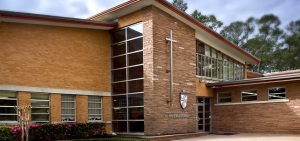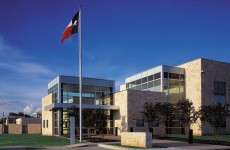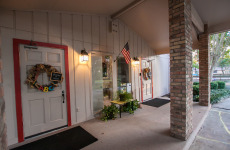With National Catholic Schools Week (January 25th-31st, 2015) in full swing, we reached out to St. Pius X High School to discuss the value of a Catholic school education in 2015.
At the corner of North Shepherd and West Donovan Street stands St. Pius X High School. Billed as Houston’s premier co-ed Catholic high school, the lovely campus ensconced by wrought-iron fencing and captivating trees begins the transition into the neighborhood of Garden Oaks.
St. Pius X boasts enrollment from across the Greater Houston area, stretching as far south as Webster and as far north as The Woodlands, serving students from 126 different zip codes. Driving to the campus from South Shepherd to North, the students the school serves come from neighborhoods that differ not only in location, but in background, religious affiliation, ethnicity and economic class.
Diane Larsen, St. Pius X’s Academic Dean, believes that students of St. Pius X benefit from the school’s heterogeneous composition by opening student’s “view of the world.”
Entering the lobby of St. Pius X feels like walking into a beloved alma mater. Lockers line the walls and the current generation roams the halls in their smart polo shirts emblazoned with the Dominican slogan, “Veritas.” Ms. Larsen generously provides a warm reception and quickly offers a seat in her office. She immediately begins with a rundown of the campus’ background, mirroring the school’s general attachment to its history.
St. Pius X was built in 1956 by the Dominican Sisters of Houston as they sought to further their reach and commitment to serve the Northwest Houston community and its baby boomer generation. Since then, the Northwest Houston community has seen many changes and developments. But as it stands in 2015, St. Pius X has an enrollment of 687 students and counting.
“Some of our students parents work nearby, some are children of alums. Some are here specifically for a Catholic education, but all are welcome,” Ms. Larsen says, describing how some of the students arrived at SPX.
When asked about how St. Pius X exemplifies an ideal Catholic school education, Ms. Larsen points to the many ways the school has implemented various initiatives and programs in the last decade to uphold each of the four pillars of Dominican Schools, which include prayer, study, community and preaching.
Prayer – St. Pius X is dedicated to developing student’s spirituality, while still respecting the religious backgrounds and affiliations of all of its students. Each student is required to take four years of theology, encompassing a thorough knowledge and understanding of Catholicism, Christianity and other world religions. Ms. Larsen acknowledges that theology at the school is intended to provide the school’s impressionable teens with a sense of direction and a strong moral compass.
“It’s so easy for students to get lost during their teen years. We teach our students to seek ‘Veritas’ – truth – in everything they do,” says Ms. Larsen of how St. Pius X encourages students to follow the moral lessons instilled in them from their freshman year.
Study – Some of the cornerstone programs enhancing St. Pius X’s commitment to high-quality college preparatory education include Learning for Success, Honors/Dual-Credit/AP class offerings and the most recent addition, a Bring Your Own Device program aimed at affordably integrating technology into the classroom.
St. Pius X’s Learning for Success program is a one-of-a-kind service offered for an additional fee in the tuition of students who qualify to benefit from the program’s offerings. Since its formation in 2007, the program has served hundreds of SPX students with a variety of learning and developmental differences. The Learning for Success program, touted as one of the best in Houston for students with special needs, helps students with a variety of learning differences like ADD, processing disorders, those on the Autism spectrum, and those requiring special learning accommodations related to vision and hearing. The program has proven to be invaluable to students and parents alike, producing college acceptance letters from over 40 universities across the country and a National Merit finalist.
SPX students enrolled in the Learning for Success program benefit from additional tutoring, classroom support, math and reading assistance, summer programs, special accommodations, parental support, counseling and individualized assistance throughout their high school career. The program features support from the nationally recognized READ180° reading and writing intervention program and ASCEND math support program.
One of the most inspiring features of the program is the specially designed Paul A. Gilliam ’98 Learning Center, which houses additional classrooms, computers and learning support tools to help students in the program. The Gilliam Center was named in honor of one of the first students to benefit from the curriculum in its earliest iteration, who passed in 2010.
Additionally, all eligible students can benefit from the school’s Honors, Dual-Credit and AP courses, designed to provide students with a jump on college readiness. When asked about how dual-credit and AP courses compare, Ms. Larsen noted that each program is designed to offer students an opportunity to be exposed to college-level material and gain credit upon graduation. “Every student is different, but by offering both programs, we give more students the chance at getting pre-requisites out of the way now, so they have more options later in their junior and senior years of college.”
Introduced in 2013, SPX’s Bring Your Own Device program rounds out the school’s current tech program. Students have the opportunity to utilize their own device at school, whether it be a laptop, tablet or phone, to enhance their research and progress for each assignment. Devices are only permitted by the instructor, however, Ms. Larsen has observed that most parents have embraced the program and have witnessed students benefiting from the program.
The school’s wireless network prevents students from accessing illicit content while on school grounds, and additionally, students are entrusted to the school’s honor code and acceptable use policy. The school’s 52 faculty members worked with Ms. Larsen to develop a curriculum to teach students digital citizenship in order to appropriately integrate technology into their existing lesson plans. Each teacher integrates lessons regarding digital access, commerce, communication literacy, law, rights & responsibilities, health & wellness, etiquette and security into the subjects they currently teach to help students navigate the murky waters of the internet, in order to teach them to discern fact from fiction while online.
Community – Notably, St. Pius X is heavily diverse. When walking the halls, students from varying ethnic and national backgrounds mingle and commune together. In the classrooms, they huddle around books and computers together, sharing their knowledge and perspectives with one another. As their Friday comes to a close before the long Martin Luther King Jr. weekend begins, they smile together in the library and laugh for a few moments before departing for their separate homes in different communities around the city.
Ms. Larsen says the benefits of having such a close-knit and diverse community is what makes St. Pius X a treasure to both the Houston and Catholic educational communities. Ms. Larsen’s own daughter chose to attend St. Pius X, noting in large part the school’s diverse community as a driving factor in her decision. When asked by her mother whether or not her education at St. Pius X helped prepare her for the tremendous diversity of college life at New York University, Ms. Larsen quotes her daughter, saying “most definitely,” with a smirk.
Additionally, the school is committed to serving the city of Houston. With dozens of sports and outside of school activities and organizations, St. Pius X students remain well-rounded. The school features strong and equal representation across gender lines in organizations like National Honor Society, Student Council, Honor Board, and Climate of Character Board, just to name a few.
The school recently began its own chapter of Best Buddies, a nationally recognized organization dedicated to serving and working with those who have intellectual and developmental differences, like Down Syndrome. Ms. Larsen noted that the new organization has helped improve student’s tolerance and increase awareness of how to assist those with developmental differences.
SPX students are also required to complete 100 hours of community service between their junior and senior year to earn a Christian Service Learning credit required for graduation. Junior and senior students must complete their hours, attend a school sponsored retreat and complete a reflection paper outlining their experiences to solidify the lessons learned and experience gained by serving their community.
Preaching – Ms. Larsen twice notes the continued importance of the Dominican Sisters of Houston and their tradition of service, social justice and community development. While touring the building near the front office there are small, wooden doors which Ms. Larsen indicates as the former home of the Dominican Sisters who used to inhabit the school years ago. When asked about the school’s unique location in comparison to some of Houston’s other prominent private and Catholic schools, Ms. Larsen remembers years ago when there were calls to move the school further north. The Dominican Sisters quickly put a stop to those plans, stating SPX was built to “serve the community in which it was first built.”
In tandem with the Dominican Sisters’ message, Ms. Larsen sees St. Pius X as a family, dedicated to both preaching and teaching – walking the walk and talking the talk, so to speak. As the day ends, she hosts a student in a nearby classroom who’s finishing an assignment before the weekend begins. Ms. Larsen acknowledges the particular leaps and bounds the school’s teachers and administrators have taken with this student, and others similar who’ve needed extra support to get through their lessons and achieve academic success.
“We strongly believe in doing whatever it takes to make our students successful,” Ms. Larsen remarks, speaking of students who benefit from the additional assistance from teachers and the Learning for Success program. “We owe more to kids who don’t live in lock-step manner. They can handle what we give them, if we provide them with adequate support.”
In looking towards the future of the school, Ms. Larsen has some clear goals on the horizon. Jokingly, she mentions hope for a state football championship, but also lists completing the school’s planned building addition to support their growing science, technology and media programs. She spreads blueprints and mock-ups across her table of a redesigned library featuring state of the art tools and resources to help students in class projects and research.
“I can see our school growing to accommodate almost 700 students in the next few years. Probably around 800 after we’re finished with construction. I’m also looking forward to further integrating online classes and blended learning into our existing curriculum,” Ms. Larsen says of her goals for the future of St. Pius X.
As the school day closes and students vacate the school halls for home, toting backpacks and grins, excited to start the weekend, there is a sense of general uplift and contentment exchanged among students and teachers alike. The administrators and staff appear jovial and at peace. The statue of St. Pius X in the lobby seems to have blessed the campus with equal love and support for students, from the baby boomers who once walked the halls to the current generation, some the grandchildren of the former. While some may ask if a Catholic school education is relevant or viable in an era of rapid development and ever changing times, St. Pius X has answered that question with a resounding yes.















